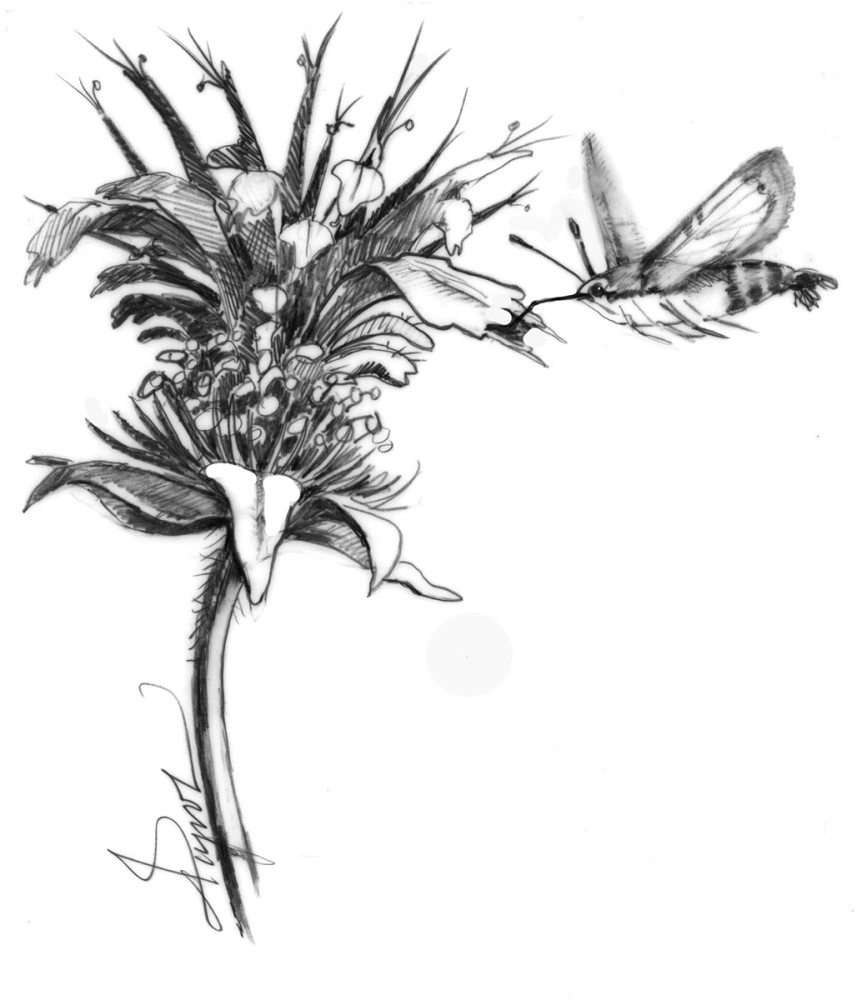
One afternoon last summer, my partner Rick called me out onto our deck to see a tiny hummingbird. Not just tiny, but the tiniest hummingbird he had ever seen. My curiosity piqued, I walked out and there it was – hovering in front of the bee balm, sipping nectar and beating its wings at an impossible rate. It was a rich rust color and about an inch and a half long. By comparison, the smallest ruby-throated hummingbirds are twice that length. This was truly the most diminutive hummingbird imaginable.
Or was it? When I first spotted it, I was certain it was not a hummingbird. It didn’t seem possible that in all my years of birdwatching, I had never seen this particular species, nor even heard of it. A one-and-a-half-inch-bird, after all, would be something of note. The kind of thing people spend their lives hoping to see, crowds gathering as word of a sighting spread. But the longer I watched it, the less sure I felt. It moved exactly like a hummingbird – hovering, sipping, furiously flapping. I wondered if we had stumbled upon a wayward bird far afield from its home somewhere in the tropics.
We had not. It was a moth.
More specifically, it was a hummingbird moth - a tiny trickster that sounds, acts, and looks much like its namesake. There are several species that fall into this family, known as the Sphingidae or sphinx. The most common in our area, and the one zipping around my garden, is the hummingbird clearwing moth (Hemaris thysbe). Another common species, the snowberry clearwing (Hemaris diffinis), tends to be more abundant in the West. (There is also a genus, Macroglossum, found in North Africa, Asia, and Europe. It is known as the hummingbird hawkmoth and has an epic migration, some of them flying from the Mediterranean and even North Africa to the United Kingdom.)
After the sighting in my garden, I did an internet search on “tiny hummingbird” and discovered that I was not the first person to be fooled. Looking at photos of the insect, I could clearly see it was just that – an insect and not a bird. What looks like a sliver of a beak is actually a proboscis that the moth plunges deep into blossoms for nectar. When not in use, it retracts into a coiled position. It also sports a pair of unbird-like antennae. Details that were hard to see as it flitted about the bee balm in the middle of a sun-drenched day.
Even in caterpillar form, the Hemaris thysbe is easy to mistake for something else. It’s a beautiful spring green, with spots along its sides and a horn on its rear end. In other words, it is almost identical to the tomato hornworm. “All caterpillars in the family Sphingidae have a horn at the rear end,” said biologist Beatriz Moisset, who writes about pollinators for the U.S. Forest Service. “They look similar to tomato hornworms, but feed on different plants, mostly honeysuckles, viburnums, snowberries, and a few others.”
I was relieved to learn this, as I have had an infestation of tomato hornworms two summers in a row and didn’t want to regret the fates they met at my hands. Turns out those garden decimators transform into five-spotted moths and not into the bird look-alikes checking out my bee balm.
Adult hummingbird moths first emerge in spring, but are most active in summer, when flowers such as bee balm and phlox are in bloom. Females lay eggs on the underside of leaves that the larvae eat, including honeysuckle and dogbane. When the caterpillars are full grown they drop to the ground, where they will spend the winter in cocoons. Leaf litter is essential to their survival.
“An immaculate lawn is a death sentence for any pupa laying there. So, if you can reduce the area you rake in the fall, you may be saving some of these beauties” said Moisset. I’ve never been particularly zealous about raking my lawn and now I am even less so.
The sighting last summer proved to be a singular event, but I am hopeful more will follow this year. The next time a hummingbird moth shows up in my garden, I won’t be fooled, but I will be delighted.


Discussion *